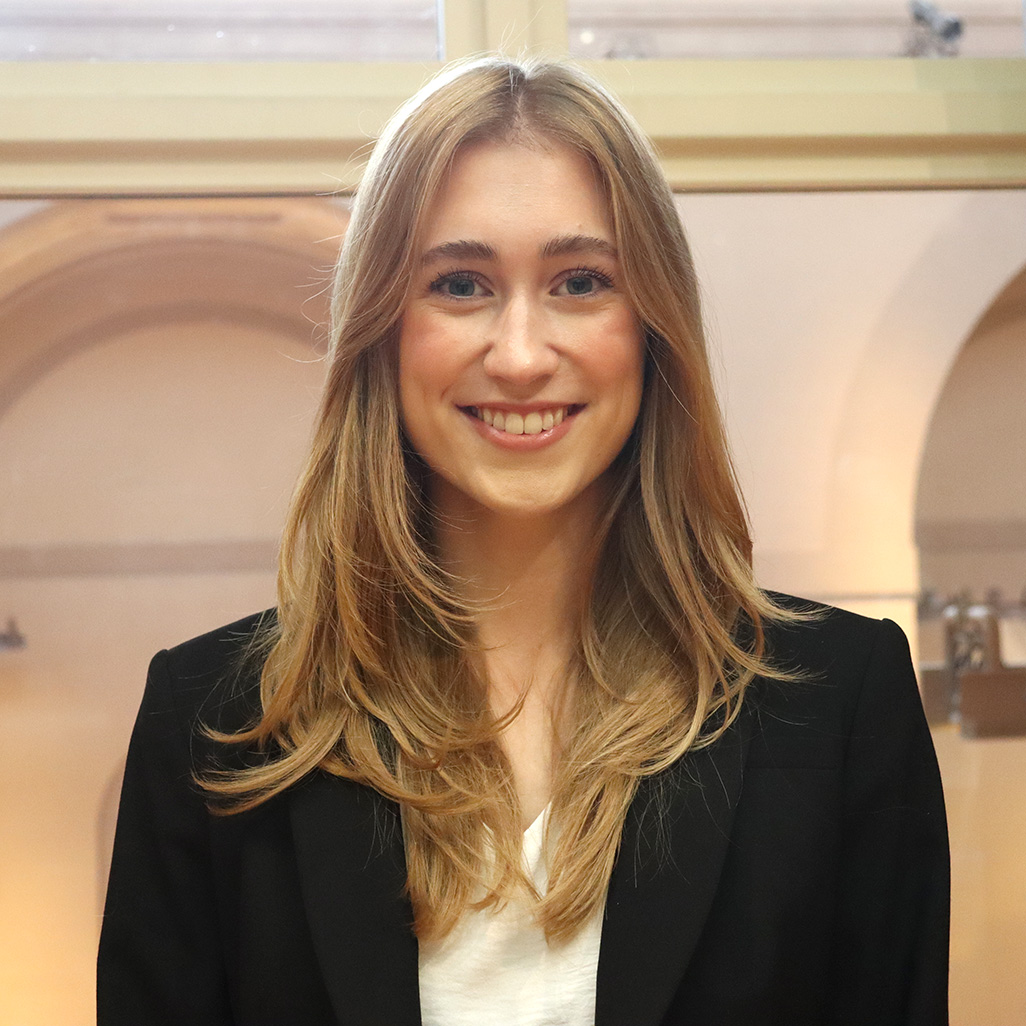Caitlyn Fong works on a Rom society mask in the Museum's objects conservation lab.
Art conservation is the long-term preservation of art and heritage. Conservators aim to not only stabilize objects for future generations but to help preserve the cultural significance and narratives that are embedded in those objects.
The Saint Louis Art Museum’s conservation summer intern, Caitlyn Fong, recently worked on the preservation of a Rom heb’ror’r mask. This mask is from the Rom society of Ambrym Island in Vanuatu, an island nation in Oceania. The head-shaped mask was made in the mid- to late 20th century, possibly to represent an animal. It is made out of plant-based materials like palm fibers and coconut husks, with a paste layer applied across the surface. The mask has red, white, and black pigments applied to the surface, with a fringe resembling hair hanging around the outer rim.
This is a rare example of a mask from the Rom culture. The delicate plant materials used in the construction of the mask have degraded over time from exposure to factors like light and temperature. Its fragile condition is why it has been selected for conservation treatment.

Ambrym Island artist; Mask (rom heb'ror'r'), mid- to late 20th century; plant matter, pigment; 11 x 9 13/16 x 13 3/4 inches; Saint Louis Art Museum, Museum Purchase 37:2001
Fong began the conservation process by evaluating the mask’s physical state. This assessment phase allows conservators to better understand an object and determine its needs. For this mask, Fong used visual observation, optical microscopy, and ultraviolet light to determine its condition and to reveal areas of past repair. She also used high-quality digital photography paired with written documentation to record the current condition of the mask.
In parallel, Fong researched the historical background to better understand the context from which the object originates. Since little is known about the specifics of the mask, Fong conducted research on the culture and artistic practices of the Rom in Vanuatu. She learned that the Rom society is a hierarchical male group, and some knowledge, like that of the materials, creation, and performance of ceremonial masks, is only accessible to people of a particular rank. Masks are also sometimes destroyed or left to decay after use, which could explain the use of impermanent organic materials.
When preserving works of art, conservators strive to honor the historical, artistic, and cultural values embodied in each piece. Similar to fields like medicine, law, or accounting, conservators follow a professional code of ethics, which is why it is important for them to understand the cultural context of the objects they are treating.

Caitlyn Fong examines a Rom society mask in the Museum's objects conservation lab.
Given the culturally sensitive information associated with this mask, analysis and treatment had to be considered carefully. For other objects, analytical methods such as x-ray radiography or polarized light microscopy (different from optical microscopy) can be utilized to identify their structure and materials. For this mask, material analysis was intentionally limited out of respect for the cultural values associated with the object.
Only x-ray fluorescence (XRF) analysis was conducted on this mask, solely for health and safety concerns. XRF is a technique used for elemental identification of materials and in this case was used selectively to determine if there were any heavy-metal pesticides on the mask. Fortunately, no such pesticides were detected. Up until the late 20th century, collectors and museums applied toxic pesticides like arsenic and mercury as a preservative to organic objects. These chemicals retain their toxicity, and contaminated objects continue to pose a health risk today.
Once enough information had been gathered, Fong collaborated with Nichole Bridges, the Morton D. May Curator of the Arts of Africa, Oceania, and the Americas, curatorial assistant Amy Clark, and assistant objects conservator Amaris Sturm to discuss approaches to treatment. The team sought to strategize a treatment plan that struck a balance between stabilizing the object and respecting the restrictions the Rom society may have for the mask. Through their discussion, a middle-ground approach was agreed upon. Steps would be taken to stabilize the actively degrading materials, but certain treatment steps would be saved for a later date so more contextual information could be gathered. This allowed Fong to care for the object and mitigate risks of further degradation while still respecting the mask’s cultural value.

Assistant objects conservator Amaris Sturm and objects conservation intern Caitlyn Fong discuss treatment options for a Rom society mask.
Fong began the treatment by carefully removing surface dust with a soft brush and vacuum. She then stabilized areas of flaking and powdering pigments with a natural, cellulose-based adhesive. Since the mask is made out of organic materials, Fong made the decision to use only naturally derived substances to best respect the original integrity of the object. There is precedent for this in the conservation field, where some communities have not wanted synthetic or animal-based adhesives used on their cultural objects. She then supported unstable structural elements with toned strips of mulberry tissue adhered with the same natural adhesive. Mulberry tissue is commonly used in conservation because of its longevity, strength, and versatility.
With treatment completed, decision making continues with the storage and display of the mask. The choices made by the stewards of this object in the future will continue to affect the physical and intangible aspects of the mask.
Brenna Coleman was the 2024 summer marketing and communications intern at the Saint Louis Art Museum. She is an undergraduate student at Indiana University-Bloomington studying arts management.
Caitlyn Fong was the 2024 summer graduate intern in the objects conservation department at the Saint Louis Art Museum. She is a National Endowment for the Humanities Graduate Fellow at the Winterthur/University of Delaware Program in Art Conservation.

